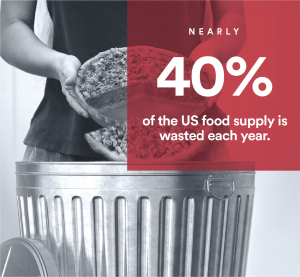Organics remain the largest single component of municipal solid waste (MSW) in the US, and while its rate of decomposition is relatively fast compared to petroleum-based materials such as plastic, the sheer amount of it can pose challenges for cities trying to effectively divert food waste. Whether its organic waste, yard trimmings, or even biodegradable packaging, optimizing systems to manage the organic waste issue is important.
 Composting is currently the most environmentally beneficial way to handle organic waste today and is among the cornerstones of a more circular economy. It also keeps food waste out of landfill and enriches the soil.
Composting is currently the most environmentally beneficial way to handle organic waste today and is among the cornerstones of a more circular economy. It also keeps food waste out of landfill and enriches the soil.
Here, we look at how commercial composting works, with a special focus on New York and the city’s latest push towards zero waste. Commercial composting has the potential to eliminate waste, revitalize soil, and combat global warming, here’s how.
What is commercial composting?
At its most basic level, commercial composting works in exactly the same way as the compost piles you’re used to—it is, after all, a natural process of decomposition. The perfect compost pile requires a range of inputs: green inputs such as nitrogen-rich food waste; brown inputs such as dry, carbon-rich yard trimmings; oxygen; and water. When combined, these elements encourage the growth of microorganisms which raise the temperature inside the compost pile and break down the organic matter over time.

Source: reliablewater247
While many commercial composting facilities are similar to those you find in your garden, just on a larger scale, there are other methods of dealing with organic waste. These methods can help to deal with problematic materials such as meat and bones, meaning commercial composting has the potential to deal with all kinds of organic waste, unlike a simple compost pile.
Naturally, commercial-scale facilities require a greater degree of organization, including “pile” management and logistical coordination when collecting materials, alongside sensitivity to the local environment and where residents are located. However, the end product (i.e. the compost), is usually much higher quality than an average home pile. In part, this is due to careful management and a broader range of organic inputs available.
Commercial composting methods
There are three main commercial composting methods, although other methods may also be used within the industry, particularly as technology advances and new processes are developed. The most popular conventional commercial composting methods are:
Windrow Composting
This method of commercial composting piles waste into long rows (windrows) between four and eight feet high and 14 to 16 feet wide. Waste is periodically turned to introduce oxygen. High temperatures created by large piles can break down problematic materials.

Source: Environmental Expert
Static Pile
This method of commercial composting is very much like the way you would compost at home. Waste is loosely piled and then layered with bulking agents to allow oxygen to permeate the pile. In larger facilities, a network of pipes will also blow air from the underside of the pile.

Source: Novid
In-Vessel
This method of commercial composting is different from the other two, using anaerobic reactions to break down waste. Organics are placed in a drum or large silo and hermetically sealed, with mechanical mixing taking place periodically. In this carefully controlled environment, organics such as meat and bones can be processed.
In many cases, commercial compost piles will be covered in order to keep off excess rainwater, while pests and odors are kept to a minimum through careful management. The final product may be sold to consumers or used in municipality projects, creating truly circular waste management solutions for organic materials.
Challenges faced by commercial composting facilities in New York
Naturally, composting is always preferable to landfill, however, there are numerous challenges faced by the commercial composting industry that are not easily solved. New York, in particular, shares a fair amount of these challenges, and minimizing organic waste at the source should remain a priority. By doing this wherever possible, the DSNY has a much greater chance to surmount the following issues:
- Logistics – In New York, businesses are responsible for arranging the collection of their organic waste, however, residential citizens are not. In some cases, residents could be responsible for setting up their own composting services. If DSNY rolls out organics composting to certain neighborhoods for high rises, residents in smaller buildings or homes are encouraged to reach out to DSNY to see if they can sign up if their property manager agrees to allow it.
- Contaminated waste streams –Organics mixed with non-organic materials remains a problem for some commercial composting facilities. While New York has introduced infrastructure that leverages sorting technology to get rid of contaminants, not all facilities can sort materials effectively on commercial scales, and toxic or harmful products may end up mixed with the final compost.
- Location – While commercial composting facilities manage to minimize odor and pests to great effect, there may still be a problem if placed too close to human residence. They also take large amounts of space, so ensuring facilities are correctly located in built-up areas such as New York is problematic which is why NYC leverages additional processing methods for organic waste such as anaerobic digestion.
- Gasses and leachate – While composting is considered circular, it does still give off harmful gasses (CO2 and methane) and leachate, which can pollute groundwater, but are far less harmful than if it were in a landfill due to the presence of oxygen.
Composting conscientiously in NYC
Composting conscientiously in New York is extremely important. Education is perhaps the first place to start, and ensuring you are aware of what can and cannot be processed by your local commercial composting facility is vital. In addition, minimizing food waste wherever possible must always be the priority, helping to relieve the burden on commercial composting facilities while also making the best use of non-renewable resources.
For NYC-based businesses, remaining compliant and up to date with the latest regulations is also important, helping you and your staff efficiently deal with organic waste while ensuring you are not breaking the law. Additionally, partnering with responsible waste and recycling companies to distribute organic waste to the correct facilities while educating staff on best practice waste management should be a priority.
Composting remains an effective form of recycling and growing our capacity to compost organic waste is at the forefront of the zero waste movement across the entire country.
Want more information on how your business can improve composting and recycling rates?


